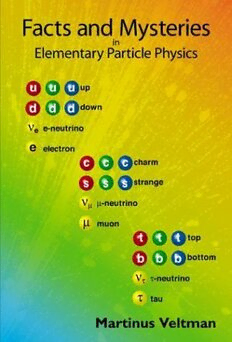Table Of ContentFFIRS.qxd 6/16/04 8:37 AM Page iv Quark03 Quark03:Desktop Folder:Chapter-FM:
FFIRS.qxd 6/16/04 8:37 AM Page iv Quark03 Quark03:Desktop Folder:Chapter-FM:
Published by
World Scientific Publishing Co. Pte. Ltd.
5 Toh Tuck Link, Singapore 596224
USA office: Suite 202, 1060 Main Street, River Edge, NJ 07661
UK office: 57 Shelton Street, Covent Garden, London WC2H 9HE
Library of Congress Cataloging-in-Publication Data
Veltman, Martinus.
Facts and mysteries in elementary particle physics / Martinus J.G. Veltman.
p. cm.
Includes index.
ISBN 981-238-148-1 -- ISBN 981-238-149-X (pbk.)
1. Particles (Nuclear physics) I. Title.
QC793.2.V45 2003
539.7'2--dc21 2003042273
British Library Cataloguing-in-Publication Data
A catalogue record for this book is available from the British Library.
Copyright © 2003 by World Scientific Publishing Co. Pte. Ltd.
All rights reserved. This book, or parts thereof, may not be reproduced in any form or by any
means, electronic or mechanical, including photocopying, recording or any information
storage and retrieval system now known or to be invented, without written permission from
the Publisher.
First Edition
10 9 8 7 6 5 4 3 2
For photocopying of material in this volume, please pay a copying fee through the
Copyright Clearance Center, Inc., 222 Rosewood Drive, Danvers, MA 01923, USA. In this
case permission to photocopy is not required from the publisher.
Printed by FuIsland Offset Printing (S) Pte Ltd, Singapore.
v
Table of Contents
Introduction 1
Acknowledgments 5
Further Reading 5
Thumbnail Sketches 6
Equations 7
1 Preliminaries 8
1.1 Atoms, Nuclei and Particles 8
1.2 Photons 15
1.3 Antiparticles 19
1.4 Mass and Energy 21
1.5 Events 24
1.6 Electron-Volts and Other Units 30
1.7 Particle Names and the Greek Alphabet 32
1.8 Scientific Notation 33
2 The Standard Model 35
2.1 Introduction 35
2.2 Conservation of Energy and Charge 40
2.3 Quantum Numbers 43
2.4 Color 45
2.5 The Electron-Neutrino, Electron Number and
Crossing 49
2.6 The First Family 53
2.7 Families and Forces 55
contents.p65 5 06/30/2004, 12:15 PM
vi ELEMENTARY PARTICLE PHYSICS
2.8 The Spin 1 Particles 62
2
2.9 The Spin 1 and 2 Particles 68
2.10 Forces and Interactions 69
2.11 Classification of Interactions 71
2.12 Electromagnetic, Weak, Strong, Higgs and
Gravitational Interactions 75
2.13 Representing Interactions 77
2.14 The Origin of Quantum Numbers 83
3 Quantum Mechanics. Mixing 85
3.1 Introduction 85
3.2 The Two-Slit Experiment 88
3.3 Amplitude and Probability 92
3.4 Cabibbo and CKM Mixing 99
3.5 Neutrino Mixing 108
3.6 Particle Mixing 109
4 Energy, Momentum and Mass-Shell 115
4.1 Introduction 115
4.2 Conservation Laws 118
4.3 Relativity 126
4.4 Relativistic Invariance 131
4.5 The Relation EE=mc2 136
5 Detection 140
5.1 Introduction 140
5.2 Photoelectric Effect 146
5.3 Bubble Chambers 152
5.4 Spark Chambers 157
5.5 Proportional Wire Chambers 159
6 Accelerators and Storage Rings 161
6.1 Energy Bubbles 161
6.2 Accelerators 165
contents.p65 6 06/30/2004, 12:15 PM
CONTENTS vii
6.3 Secondary Beams 178
6.4 The Machine Builders 181
7 The CERN Neutrino Experiment 189
7.1 Introduction 189
7.2 Experimental Set-up 195
7.3 Neutrino Physics 200
7.4 The First Neutrino Experiments 205
7.5 Vector Bosons 208
7.6 Missed Opportunities 213
7.7 Epilogue 218
8 The Particle Zoo 219
8.1 Introduction 219
8.2 Bound States 222
8.3 The Structure of Quark Bound States 225
8.4 Spin of a Bound State 229
8.5 Mesons 230
8.6 Baryons 234
8.7 Exotics 236
8.8 Discovering Quarks 237
8.9 Triplets versus Doublets and Lepton-Quark
Symmetry 241
9 Particle Theory 244
9.1 Introduction 244
9.2 Feynman Rules 246
9.3 Infinities 255
9.4 Perturbation Theory 258
9.5 Renormalizability 264
9.6 Weak Interactions 267
9.7 Compton Scattering 270
9.8 Neutral Vector Bosons 273
9.9 Charmed Quarks 276
9.10 The Higgs Particle 279
contents.p65 7 06/30/2004, 12:15 PM
viii ELEMENTARY PARTICLE PHYSICS
9.11 General Higgs Couplings 281
9.12 Speculations 282
9.13 ρ-Parameter 283
10 Finding the Higgs 285
11 Quantum Chromodynamics 293
11.1 Introduction 293
11.2 Confinement 295
11.3 Asymptotic Freedom 297
11.4 Scaling 300
12 Epilogue 304
Name Index 309
Subject Index 317
Photo Credits 337
contents.p65 8 06/30/2004, 12:15 PM
1
Introduction
The twentieth century has seen an enormous progress in physics.
The fundamental physics of the first half of that century was
dominated by the theory of relativity, Einstein’s theory of gravi-
tation, and the theory of quantum mechanics. The second
half of the century saw the rise of elementary particle physics.
In other branches of physics much progress was made also, but
in a sense developments such as the discovery and theory of
superconductivity are developments in width, not in depth. They
do not affect in any way our understanding of the fundamental
laws of Nature. No one working in low-temperature physics or
statistical mechanics would presume that developments in those
areas, no matter how important, would affect our understanding
of quantum mechanics.
Through this development there has been a subtle change in
point of view. In Einstein’s theory of gravitation space and time
play an overwhelming, dominant role. The movement of matter
through space is determined by the properties of space. In this
theory of gravitation matter defines space, and the movement of
matter through space is then determined by the structure of space.
A grand and imposing view, but despite the enormous authority
of Einstein most physicists no longer adhere to this idea. Einstein
spent the latter part of his life trying to incorporate electro-
magnetism into this picture, thus trying to describe electric and
magnetic fields as properties of space-time. This became known as
his quest for a unified theory. In this he really never succeeded,
but he was not a man given to abandon easily a point of view.
introduction.p65 1 06/30/2004, 12:15 PM

